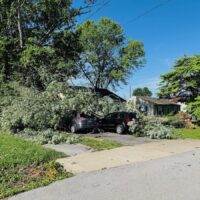The current hot, dry spell has put some of Kentucky’s 120 counties in “moderate drought” conditions. That’s having an impact on the state’s agriculture industry in some regions.

Kentucky farmers have been dealing with nature’s unpredictable extremes. Unusually wet conditions earlier this year delayed some planting, and now the long, dry spell may affect some of those late-planted crops.
(A portion of Christian County is classified as abnormally dry. See graphic.)
Stuart Foster is the state climatologist and director of the Kentucky Climate Center based at Western Kentucky University. He said the center has been getting impact reports from farmers in areas around Breckenridge, Hardin and Meade counties, as well as in some parts of eastern Kentucky, including the region around Breathitt County.
“Pastures have dried up, farm ponds have been getting low, and some of the late planted crops, there’s been quite a bit of concern about loss of yield due to the dry conditions here in the late summer,” said Foster.
About 30 of the state’s 120 counties are in “moderate drought” conditions and many other counties are designated as “abnormally dry,” according to the U.S. Drought Monitor. That online resource is a collaborative effort between several federal agencies, including the National Drought Mitigation Center, U.S. Department of Agriculture, and the National Oceanic and Atmospheric Administration.
Foster said WKU hosted the U.S. Drought Monitor Forum from Sept. 17 – 19 in Bowling Green, which drew 80 drought and climate scientists.
“We work with these many of these different agencies at the federal level on a fairly regular basis,” said Foster. “And so a big reason why folks came here to Bowling Green was the Kentucky Climate Center and our history here at Western Kentucky University.”
The U.S. Drought Monitor currently shows that counties including Breckinridge, Edmonson, Hardin and Meade are in “moderate drought” conditions, as well as some areas around Breathitt County in eastern Kentucky.
South-central Kentucky counties including Allen, Simpson and Warren are not in drought conditions.
The U.S. Drought Monitor is especially important for farmers, as it shows potential impacts to crops and water levels.
The Drought Monitor is also used by states to determine the appropriate time to issue bans on burning, which have recently been put into effect in many areas of Kentucky.
(This story first ran on Kentucky Public Radio.)





